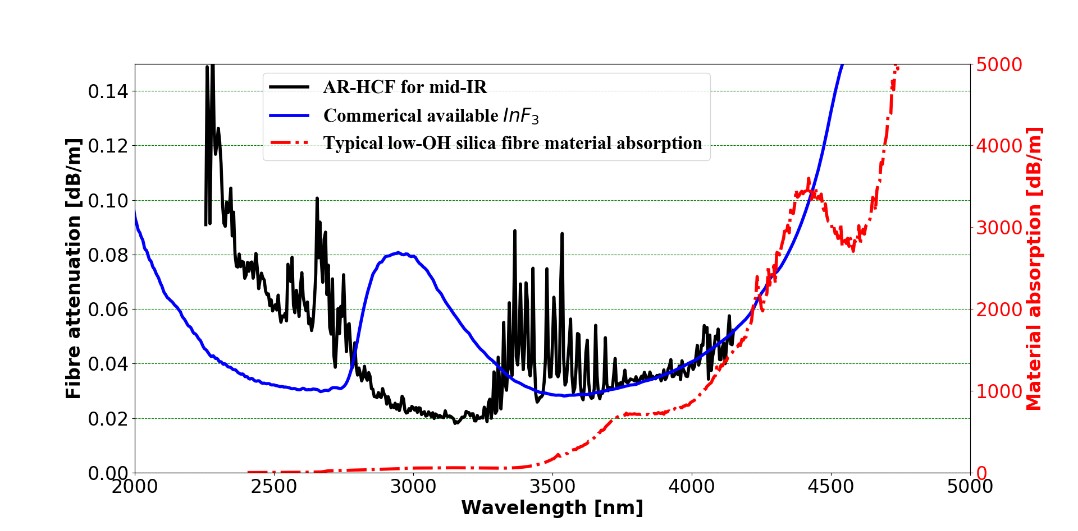Synthetic fused silica has been widely used as an optical fiber material for its high transparency in the visible and near-IR spectral range as well as its mechanical robustness, high chemical resistance and good biomedical compatibility. Unfortunately, silica fibers suffer high attenuation as well as fluorescence and photodarkening. At mid-infrared wavelengths, the phonon absorption in the silica glass rises quickly after 2.5 μm, reaching 60 dB/m at 3.5 μm and over 800 dB/m at 4 μm. Although softglasses such as Chalcogenide and Fluoride glasses exhibits much smaller absorption due to a lower energy phonon distribution, numerous challenges of material purification and synthesis and fiber fabrication remain hurdles of applicable development. Nevertheless higher optical nonlinearity and lower optical damage threshold fundamentally limit softglass fibers in laser delivery.
Recently, the collaborative research led by Dr. YU Fei in Shanghai Institute of Optics and Fine Mechanics, Chinese Academy of Sciences, and Prof. Jonathan Knight at the university of Bath in UK has successfully demonstrated a new low loss record in antireasonant hollow-core fiber at mid-infrared wavelengths, which was published in APL Photonics.
In hollow-core, fiber light is confined in an air/vacuum core rather than in the host material. Unlike index guiding solid fibers, anti-resonant hollow-core fiber realizes light transmission by strong reflection from cladding of complex structure. Anti-resonant hollow-core fibers are featured by multiple broad spectral transmission windows, low attenuations and good single-modeness.
In their experiment, 18 dB/km at 3.1 μm and 40 dB/km at 4 μm were measured in a silica based antireasonant hollow-core fiber in a cutback of over 200 meter length. In this work, approximate 2.81 × 10-5 modal overlap was achieved, which helped the silica-based hollow-core fiber surpass performance of all other softglass fibers in the same spectral region where the silica absorption as host reached up to 860 dB/m.
High damage laser power threshold, solarisation-free, radiation resistance, as well as low material absorption, low optical nonlinearity and low modal dispersion, all together made anti-resonant hollow-core fiber an ideal candidate for high-power laser in various applications and almost at any wavelengths beyond the limit of fiber material.
Photonic Spectra, the international photonic industry leading website, also reported the new progress and invited Dr. YU Fei and Prof. Jonathan Knight for a review entitled ‘Hollow-Core Optical Fibers Offer Advantages at Any Wavelength’. (www.photonics.com/Articles/Hollow-Core_Optical_Fibers_Offer_Advantages_at/a64402)
Prof. Jonathan Knight was awarded the CAS Distinguished Scientist in 2019 by CAS President International Fellowship Initiative, and appointed as Honorary Professor of SIOM.


Fig. Low-loss antireasonant hollow-core fiber for mid-IR and measured attenuation. (Image by SIOM)
Article website:
http://aip.scitation.org/doi/10.1063/1.5115328
Contact:
Mr. Cao Yong
General Administrative Office
Shanghai Institute of Optics and Fine Mechanics, CAS
Email: caoyong@siom.ac.cn